Design of a Low-Cost Multiplexer for the Study of the Impact of Soiling on PV Panel Performance
Abstract
:1. Introduction
2. Materials
2.1. Experimental Facility
2.2. Design of the UHU-MUX Multiplexer
- To obtain both electrical and temperature signals coming from the four PV modules;
- to handle the load currents available in the tracer unit;
- to be fast enough as the tracer demand;
- to work under outdoor conditions.
2.2.1. Control Stage
2.2.2. Low Power Interface
- Supply voltage: 3.75–6 V;
- Trigger current: 5 mA;
- Current when relay is active: ~70 mA (single), ~600 mA (all eight);
- Relay maximum contact voltage: 250 VAC and 30 VDC;
- Relay maximum current: 10 A.
2.2.3. PV Power Stage
2.2.4. Protection Stage
2.2.5. Terminal Block Stage
2.3. Cost of the UHU-MUX Multiplexer
3. Results
4. Conclusions
Author Contributions
Funding
Conflicts of Interest
Appendix A
| Algorithm 1: The Arduino code is detailed below |
 |
References
- International Energy Agency (IEA). Snapshot of Global PV Markets (Report IEA-PVPS T1-39:2021); International Energy Agency (IEA): Paris, France, 2021. [Google Scholar]
- Spataru, S.; Sera, D.; Kerekes, T.; Teodorescu, R. Diagnostic method for photovoltaic systems based on light I–V measurements. Sol. Energy 2015, 119, 29–44. [Google Scholar] [CrossRef]
- Álvarez-Tey, G.; Clavijo-Blanco, J.A.; Gil-García, A.; Jiménez-Castañeda, R.; García-López, C. Electrical and Thermal Behaviour of Crystalline Photovoltaic Solar Modules in Shading Conditions. Appl. Sci. 2019, 9, 3038. [Google Scholar] [CrossRef] [Green Version]
- Zdanowicz, T.; Prorok, M.; Kolodenny, W.; Roguszczak, H. Outdoor data acquisition system with advanced database for PV modules characterization. In Proceedings of the 3rd World Conferenceon Photovoltaic Energy Conversion, Osaka, Japan, 11–18 May 2003. [Google Scholar]
- Zdanowicz, T.; Rodziewicz, T.; Zabkowska-Waclawek, M. Effect of Air Mass Factor on the Performance of Different type of PV Modules. In Proceedings of the 3rd World Conferenceon Photovoltaic Energy Conversion, Osaka, Japan, 11–18 May 2003. [Google Scholar]
- Drouiche, I.; Harrouni, S.; Hadj-Arab, A. A new approach for modelling the aging PV module upon experimental I–V curves by combining translation method and five-parameters model. Electr. Power Syst. Res. 2018, 163, 231–241. [Google Scholar] [CrossRef]
- Kazem, H.A.; Chaichan, M.T. Effect of Humidity on Photovoltaic Performance Based on Experimental Study. Int. J. Appl. Eng. Res. 2015, 10, 43572–43577. [Google Scholar]
- Velilla, E.; Cano, J.B.; Jaramillo, F. Monitoring system to evaluate the outdoor performance of solar devices considering the power rating conditions. Sol. Energy 2019, 194, 79–85. [Google Scholar] [CrossRef]
- Martín-Chivelet, N.; Polo, J.; Alonso, M.; Sanz, C.; Batlles, F.J.; López, G.; Alonso-Montesinos, J.; Bosch, J.L.; Barbero, J. Characterization and modeling of the soiling effect on the PV generation under urban mediterranean conditions. In Proceedings of the 36th European Photovoltaic Solar Energy Conference and Exhibition, Marseille, France, 9–13 September 2019; pp. 1618–1620. [Google Scholar]
- Martín-Chivelet, N.; Chenlo, F.; Alonso-García, M.C.; Ariza, M.A.; Mejuto, E.; Angulo, M.; Nositschka, W.A.; Neumann, D.; Prast, M.O.; Mazón, P. Surface soiling losses measurement in pv modules under real operation. In Proceedings of the 26th European Photovoltaic Solar Energy Conference and Exhibition, Hamburg, Germany, 5–9 September 2011; WIP: München, Germany, 2011; pp. 3597–3599. [Google Scholar]
- Mani, M.; Pillai, R. Impact of dust on solar photovoltaic (PV) performance: Research status, challenges and recommendations. Renew. Sustain. Energy Rev. 2010, 14, 3124–3131. [Google Scholar] [CrossRef]
- Figgis, B.; Ennaoui, A.; Ahzi, S.; Rémond, Y. Review of PV soiling particle mechanics in desert environments. Renew. Sustain. Energy Rev. 2017, 76, 872–881. [Google Scholar] [CrossRef]
- Ferrada, P.; Olivares, D.; Campo, V.; Marzo, A.; Araya, F.; Cabrera, E.; Llanos, J.; Correa-Puerta, J.; Portillo, C.; Román-Silva, D.; et al. Physicochemical characterization of soiling from photovoltaic facilities in arid locations in the Atacama Desert. Sol. Energy 2019, 187, 47–56. [Google Scholar] [CrossRef]
- Zaihidee, F.M.; Mekhilef, S.; Seyedmahmoudian, M.; Horan, B. Dust as an unalterable deteriorative factor affecting PV panel’s efficiency: Why and how. Renew. Sustain. Energy Rev. 2016, 65, 1267–1278. [Google Scholar] [CrossRef]
- López-García, J.; Pozza, A.; Sample, T. Long-term soiling of silicon PV modules in a moderate subtropical climate. Sol. Energy 2016, 130, 174–183. [Google Scholar] [CrossRef]
- Simon, M.; Meyer, E. Detection and analysis of hot-spot formation in solar cells. Sol. Energy Mater. Sol. Cells 2016, 94, 106–113. [Google Scholar] [CrossRef]
- Yilbas, B.S.; Ali, H.; Khaled, M.; Al-Aqeeli, N.; Dheir, N.A.; Varanas, K.K. Influence of dust and mud on the optical, chemical, and mechanical properties of a PV protective glass. Sci. Rep. 2015, 5, 15833. [Google Scholar] [CrossRef] [PubMed]
- Olivares, D.; Trigo-González, M.; Marzo, A.; Ferrada, P.; Llanos, J.; Araya, F.; López, G.; Polo, J.; Alonso-Montesinos, J.; Gueymard, C. Analysis of the local factors that influence the cementation of soil and effects on pv generation at the plataforma solar del desierto de Atacama, Chile. In Proceedings of the ISES Solar World Congress 2019, Santiago, Chile, 4–7 November 2019; International Solar Energy Society: Freiburg, Germany, 2019; pp. 1021–1030. [Google Scholar]
- Elminir, H.K.; Ghitas, A.E.; Hamid, R.H.; El-Hussainy, F.; Beheary, M.M.; Abdel-Moneim, K.M. Effect of dust on the transparent cover of solar collectors. Energy Convers. Manag. 2006, 47, 3192–3203. [Google Scholar] [CrossRef]
- Kaldellis, J. K; Kokala, A. Quantifying the decrease of the photovoltaic panels’ energy yield due to phenomena of natural air pollution disposal. Energy 2010, 35, 4862–4869. [Google Scholar] [CrossRef]
- Laarabi, B.; El Baqqal, Y.; Dahrouch, A.; Barhdahi, A. Deep analysis of soiling effect on glass transmittance of PV modules in seven sites in Morocco. Energy 2020, 213, 118811. [Google Scholar] [CrossRef]
- Cordero, R.R.; Damiani, A.; Laroze, D.; MacDonell, S.; Jorquera, J.; Sepúlveda, E.; Feron, S.; Llanillo, P.; Labbe, F.; Carrasco, J.; et al. Effects of soiling on photovoltaic (PV) modules in the Atacama Desert. Sci. Rep. 2018, 8, 13943. [Google Scholar] [CrossRef] [Green Version]
- Mekhilef, S.; Saidur, R.; Kamalisarvestani, M. Effect of dust, humidity and air velocity on efficiency of photovoltaic cells. Renew. Sustain. Energy Rev. 2012, 16, 2920–2925. [Google Scholar] [CrossRef]
- Ghazi, S.; Sayigh, A.; Ip, K. Dust effect on flat surfaces—A review paper. Renew. Sustain. Energy Rev. 2014, 33, 742–751. [Google Scholar] [CrossRef]
- Rao, A.; Pillai, R.; Mani, M.; Ramamurthy, P. Influence of dust deposition on photovoltaic panel performance. Energy Procedia 2014, 54, 690–700. [Google Scholar] [CrossRef] [Green Version]
- Tanesab, J.; Parlevliet, D.; Whale, J.; Urmee, T.; Pryor, T. The contribution of dust to performance degradation of PV modules in a temperate climate zone. Sol. Energy 2015, 120, 147–157. [Google Scholar] [CrossRef] [Green Version]
- Alquthami, T.; Menoufi, K. Soiling of Photovoltaic Modules: Comparing between Two Distinct Locations within the Framework of Developing the Photovoltaic Soiling Index (PVSI). Sustainability 2019, 11, 4697. [Google Scholar] [CrossRef] [Green Version]
- Conceição, R.; Silva, H.G.; Mirão, J.; Gostein, M.; Fialho, L.; Narvarte, L.; Collares-Pereira, M. Saharan dust transport to Europe and its impact on photovoltaic performance: A case study of soiling in Portugal. Sol. Energy 2018, 160, 94–102. [Google Scholar] [CrossRef]
- Montes-Romero, J.; Micheli, L.; Theristis, M.; Fernández-Solas, A.; de la Casa, J.; Georghiou, G.E.; Almonacid, F.; Fernández, E.F. Impact of Soiling on the Outdoor Performance of CPV Modules in Spain. AIP Conf. Proc. 2019, 2149, 60004. [Google Scholar]
- Olivares, D.; Ferrada, P.; Bijman, J.; Rodríguez, S.; Trigo-González, M.; Marzo, A.; Rabanal-Arabach, J.; Alonso-Montesinos, J.; Batlles, F.J.; Fuentealba, E. Determination of the Soiling Impact on Photovoltaic Modules at the Coastal Area of the Atacama Desert. Energies 2020, 13, 3819. [Google Scholar] [CrossRef]
- Quiroz, J.E.; Stein, J.S.; Carmignani, C.K.; Gillispie, K. In-situ module-level I–V tracers for novel PV monitoring. In Proceedings of the IEEE 42nd Photovoltaic Specialist Conference (PVSC), New Orleans, LA, USA, 14–19 June 2015; pp. 1–6. [Google Scholar]
- Amiry, H.; Benhmida, M.; Bendaoud, R.; Hajjaj, C.; Bounouar, S.; Yadir, S.; Raïs, K.; Sidki, M. Design and implementation of a photovoltaic I–V curve tracer: Solar modules characterization under real operating conditions. Energy Convers. Manag. 2018, 169, 206–216. [Google Scholar] [CrossRef]
- Willoughby, A. A; Osinowo, M.O. Development of an electronic load I–V curve tracer to investigate the impact of Harmattan aerosol loading on PV module pern2tkformance in southwest Nigeria. Sol. Energy 2018, 166, 171–180. [Google Scholar] [CrossRef]
- Morales-Aragonés, J.I.; Gallardo-Saavedra, S.; Alonso-Gómez, V.; Sánchez-Pacheco, F.J.; González, M.A.; Martínez, O.; Muñoz-García, M.A.; Alonso-García, M.d.C.; Hernández-Callejo, L. Low-Cost Electronics for Online I–V Tracing at Photovoltaic Module Level: Development of Two Strategies and Comparison between Them. Electronics 2021, 10, 671. [Google Scholar] [CrossRef]
- Ameen, R.S.; Balog, R.S. Flexible and Scalable Photovoltaic Curve Tracer. In Proceedings of the 2018 International Conference on Photovoltaic Science and Technologies (PVCon), Ankara, Turkey, 4–6 July 2018; pp. 1–4. [Google Scholar]
- Alonso-Montesinos, J.; Rodríguez-Martínez, F.; Polo, J.; Martín-Chivelet, N.; Batlles, F.J. Economic Effect of Dust Particles on Photovoltaic Plant Production. Energies 2020, 13, 6376. [Google Scholar] [CrossRef]
- Maghami, M.R.; Hizam, H.; Gomes, C.; Radzi, M.A.; Rezadad, M.I.; Hajighorbani, S. Power loss due to soiling on solar panel: A review. Renew. Sustain. Energy Rev. 2016, 59, 1307–1316. [Google Scholar] [CrossRef] [Green Version]
- Tanesab, J.; Parlevliet, D.; Whale, J.; Urmee, T. Energy and economic losses caused by dust on residential photovoltaic (PV) systems deployed in different climate areas. Renew. Energy 2018, 120, 401–412. [Google Scholar] [CrossRef]
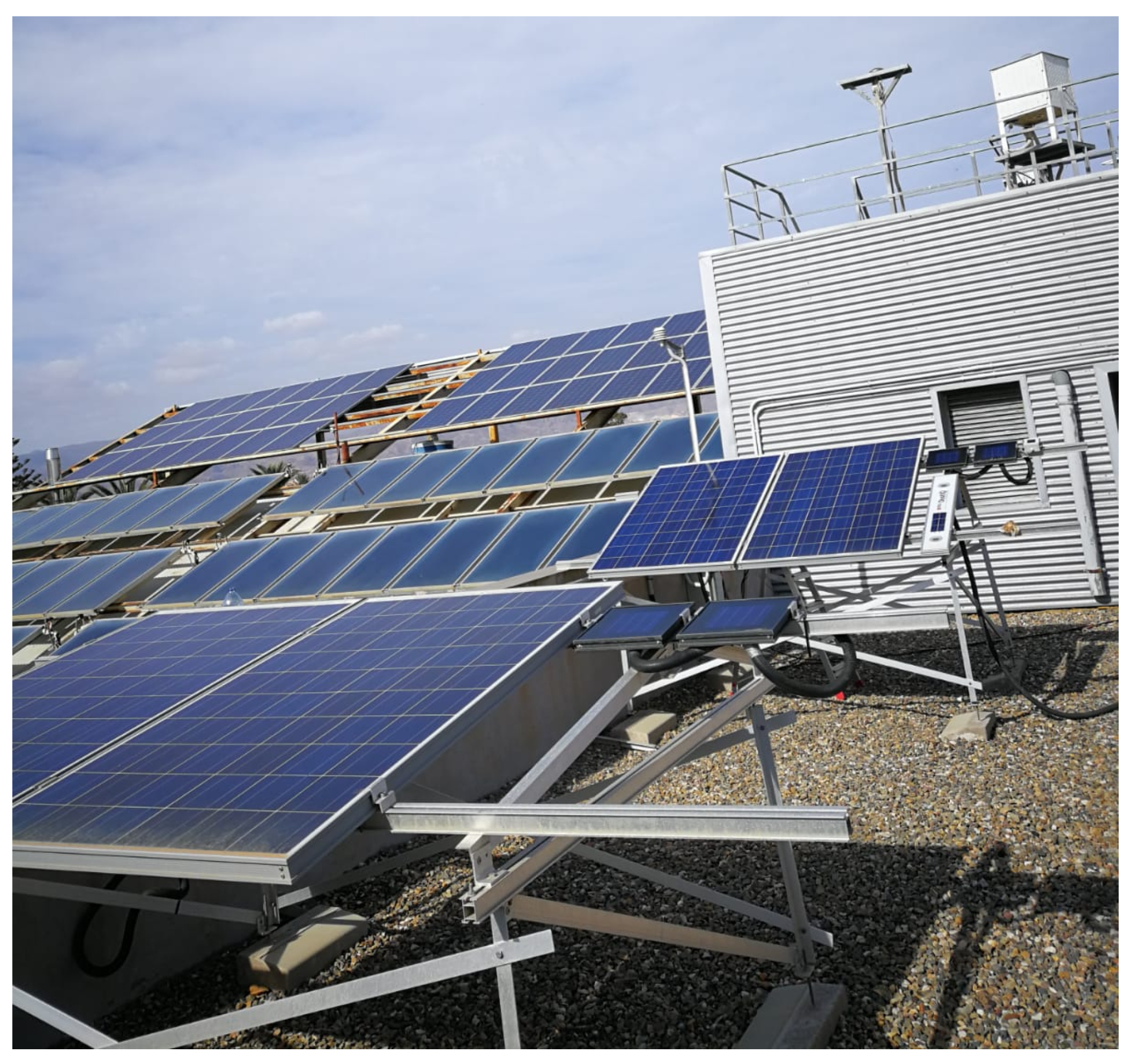
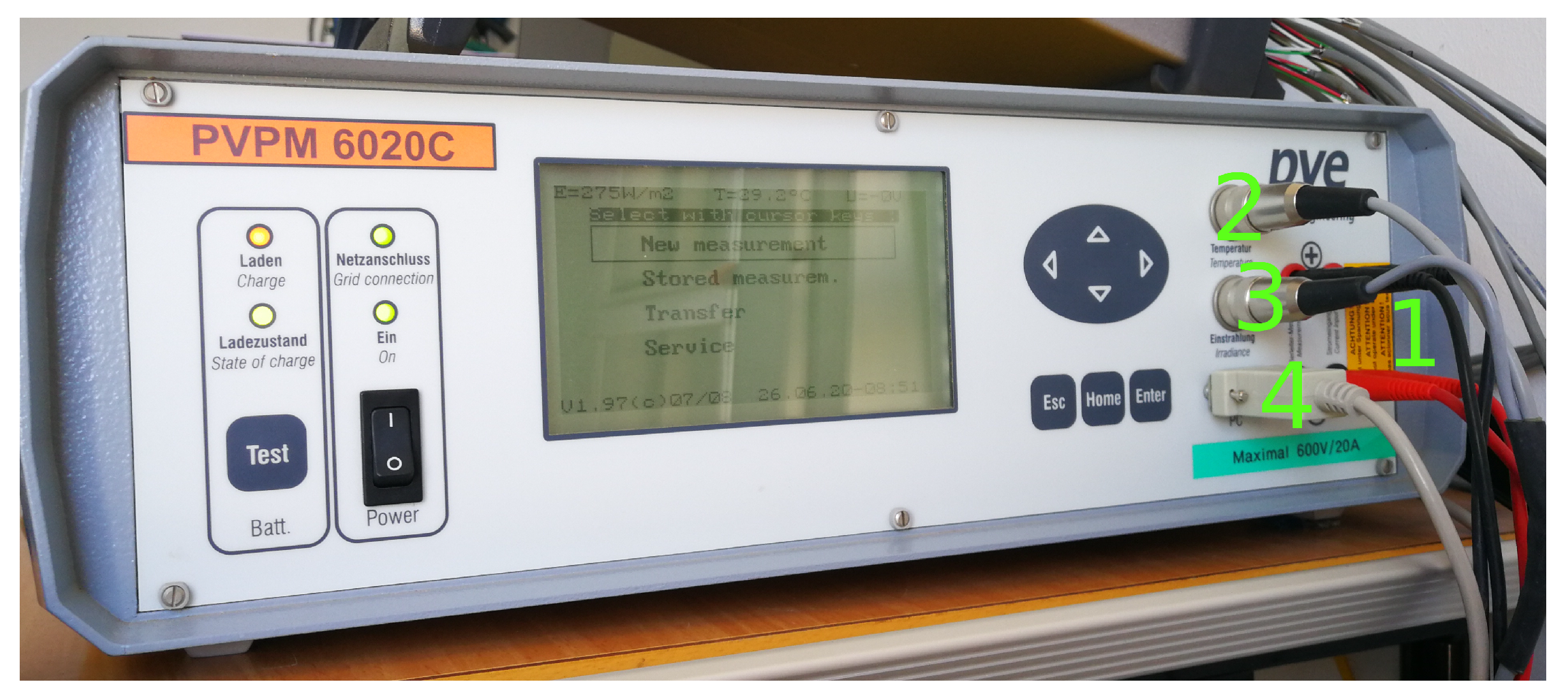
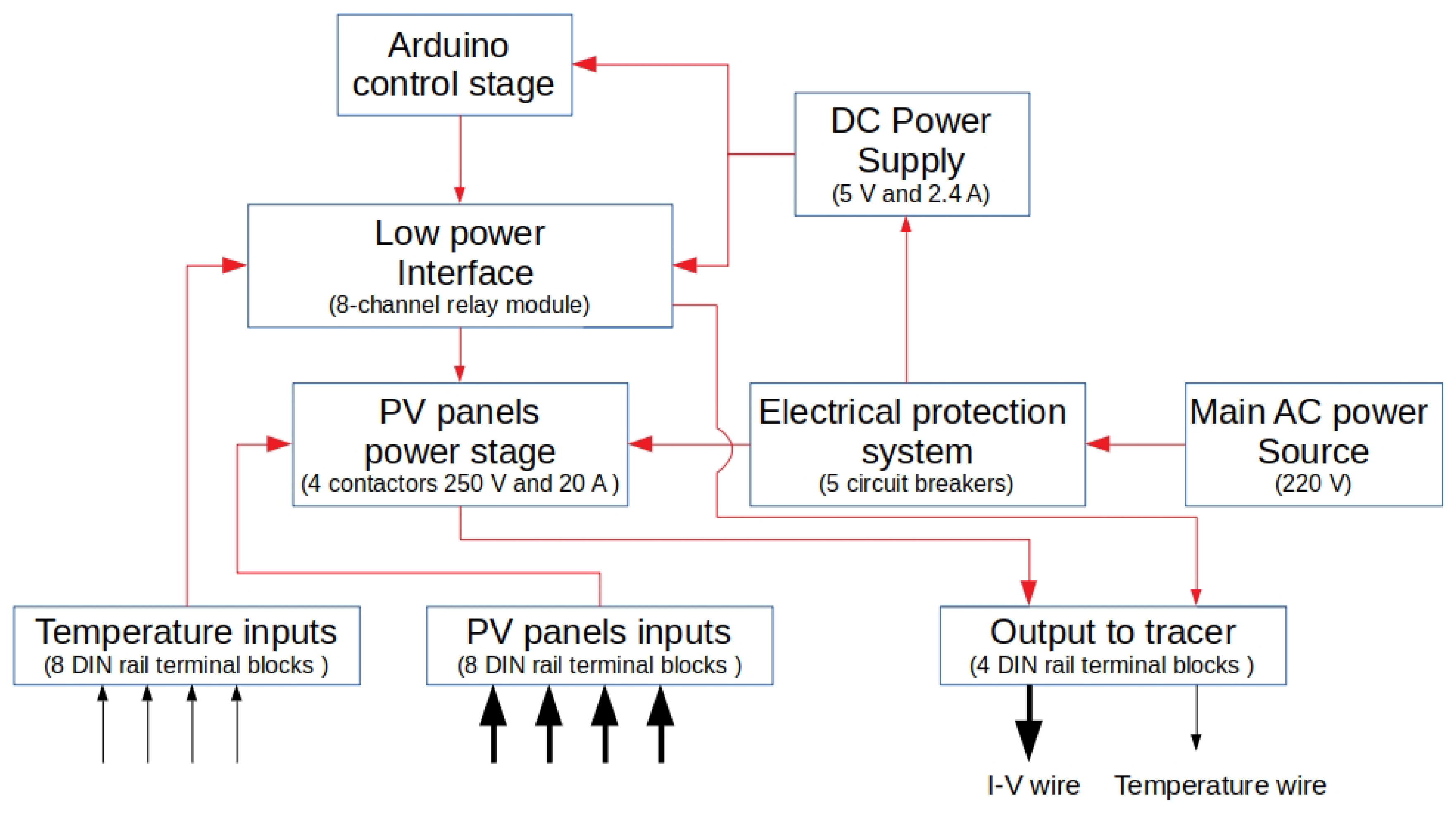
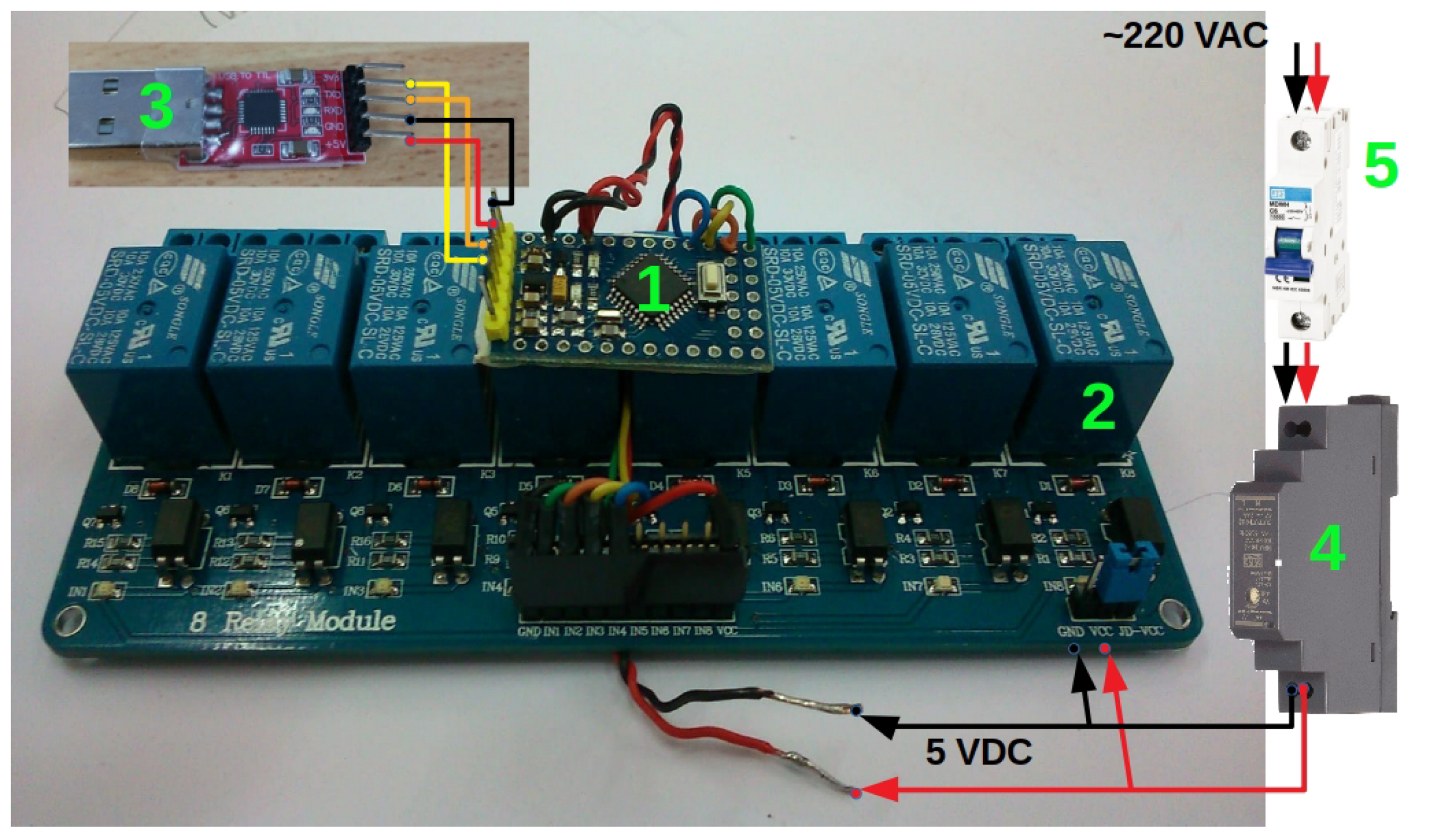
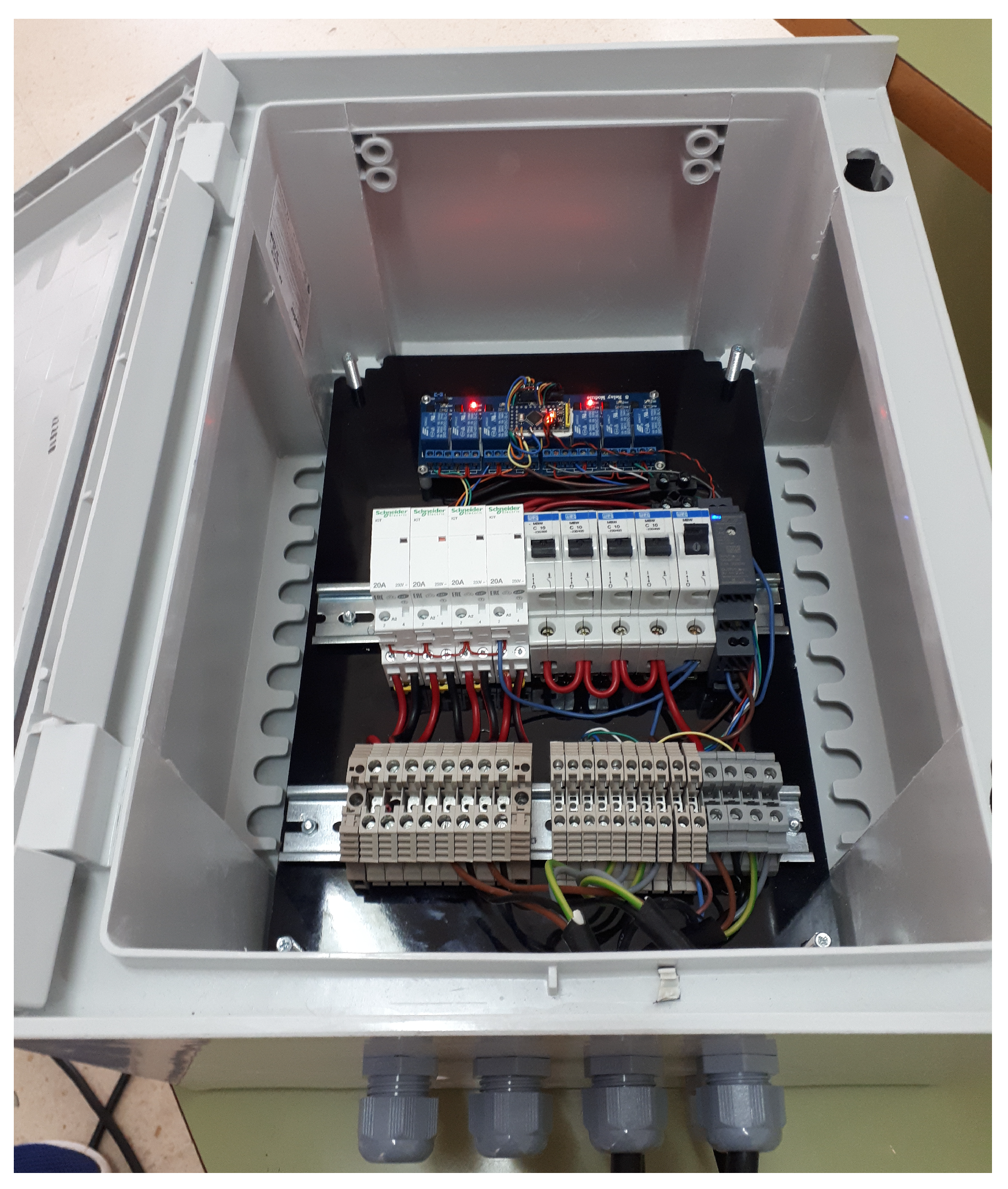
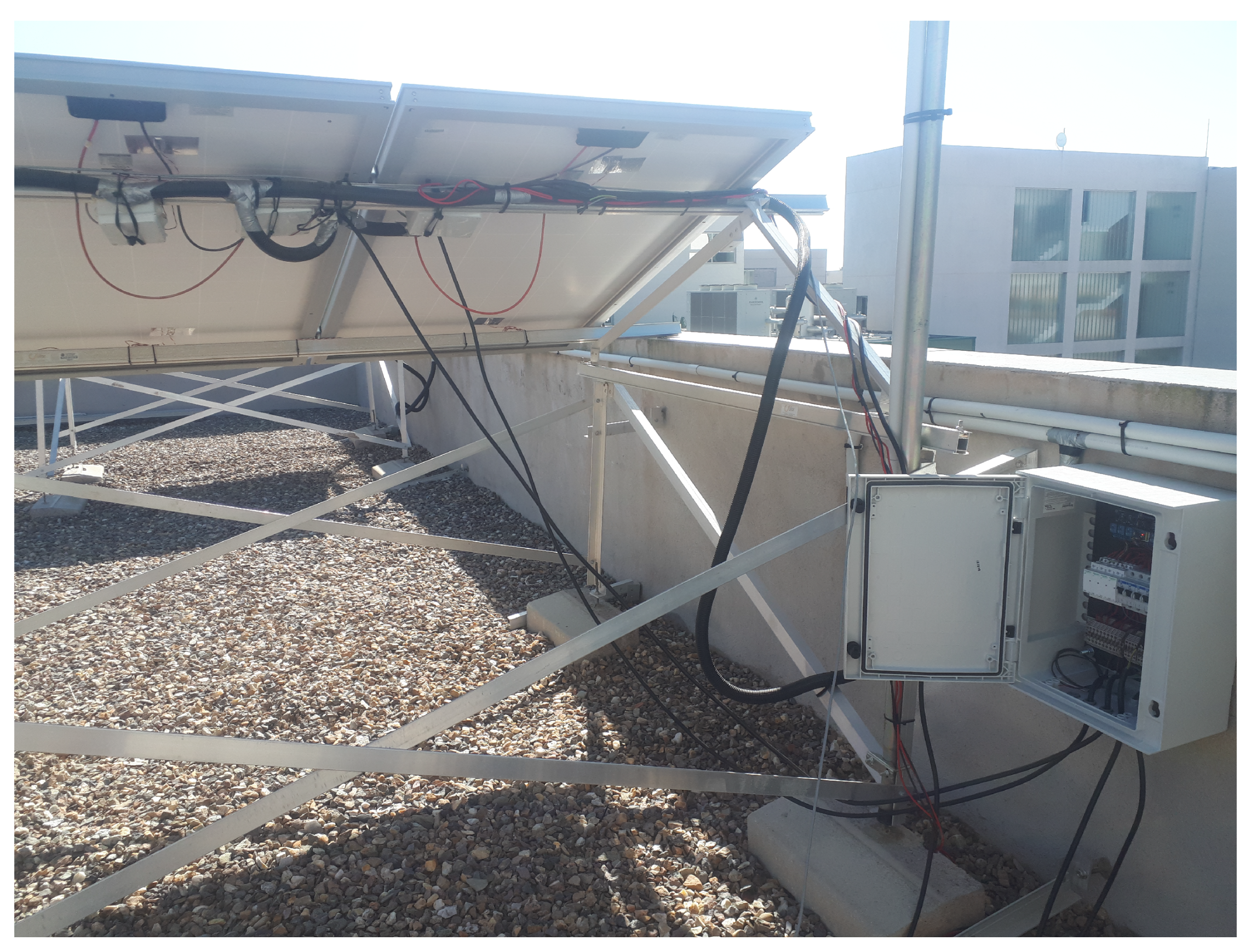
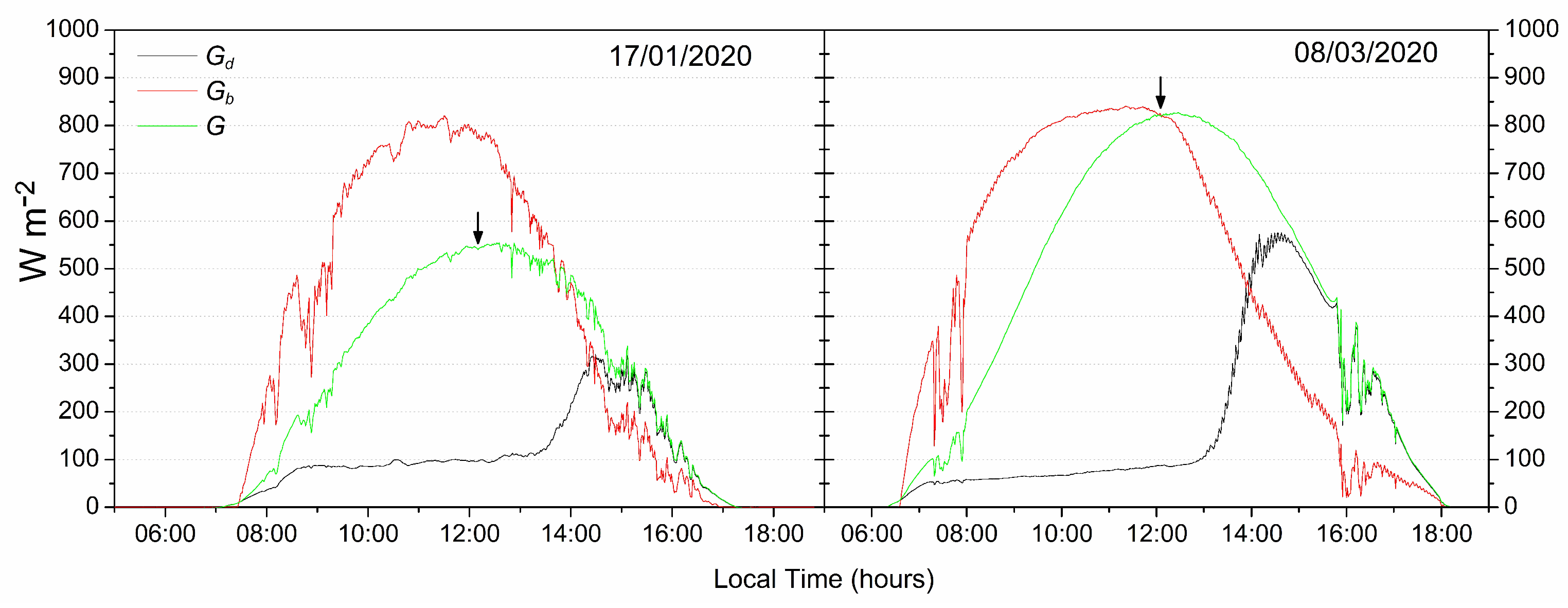
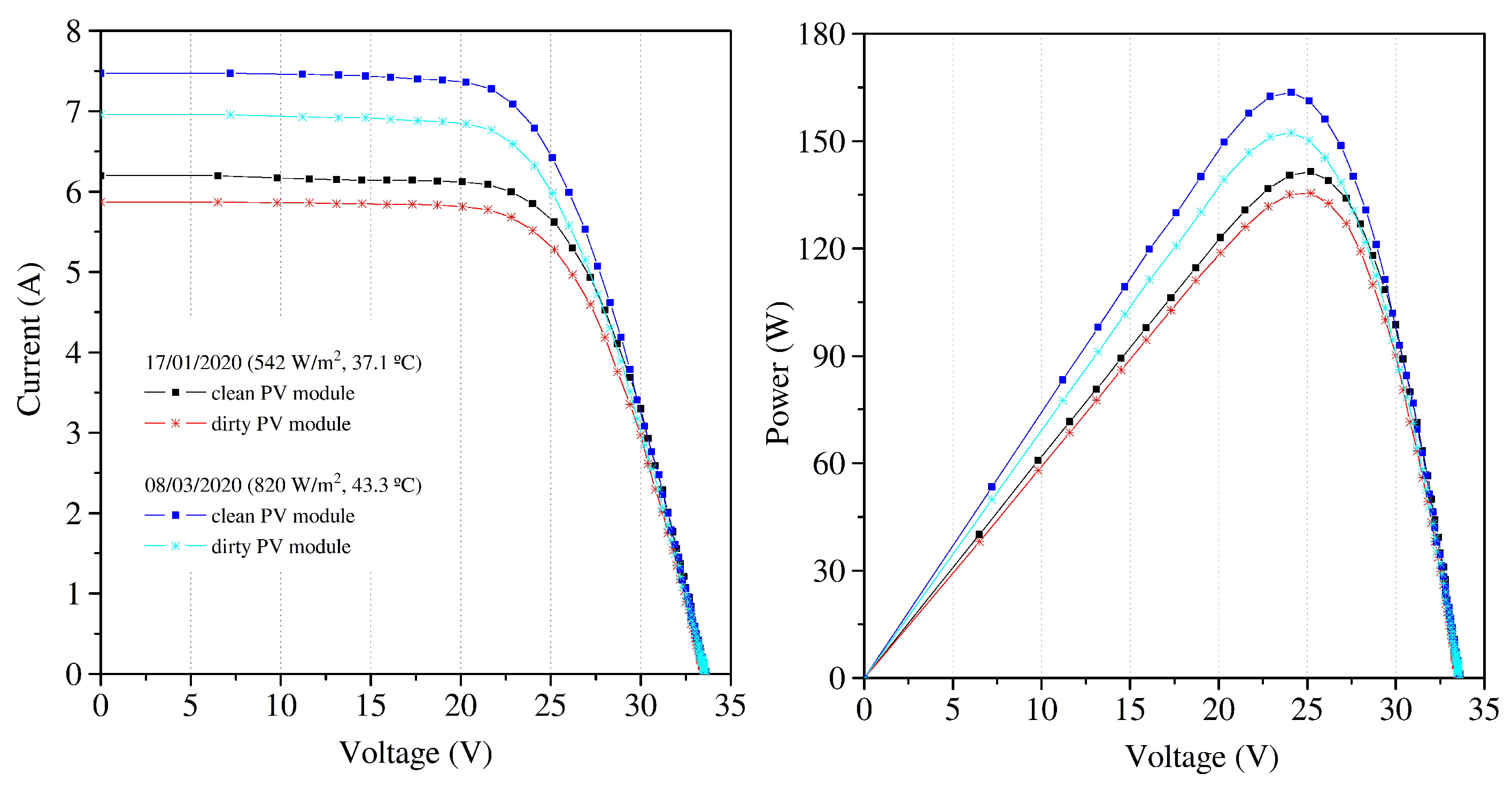
| Components | Unit Price (€) | Total Price (€) |
|---|---|---|
| One Arduino Pro Mini + USB to TTL conversor | 13 | 13 |
| One 8-channel relay module | 7 | 7 |
| One power supply | 14 | 14 |
| Five contactors | 17 | 85 |
| Five circuit breakers | 8 | 40 |
| One outdoor IP68 electrical cabinet | 145 | 145 |
| Ten cable glands | 1 | 10 |
| Total | 314 |
| 17 January 2020 | 8 March 2020 | |||
|---|---|---|---|---|
| Parameters | PV Module Clean | PV Module Dirty | PV Module Clean | PV Module Dirty |
| 6.20 A | 5.90 A | 7.47 A | 6.96 A | |
| 33.6 V | 33.6 V | 33.6 V | 33.6 V | |
| 141.5 W | 134.6 W | 163.6 W | 152.3 W | |
Publisher’s Note: MDPI stays neutral with regard to jurisdictional claims in published maps and institutional affiliations. |
© 2021 by the authors. Licensee MDPI, Basel, Switzerland. This article is an open access article distributed under the terms and conditions of the Creative Commons Attribution (CC BY) license (https://creativecommons.org/licenses/by/4.0/).
Share and Cite
López, G.; Ramírez, D.; Alonso-Montesinos, J.; Sarmiento, J.; Polo, J.; Martín-Chivelet, N.; Marzo, A.; Batlles, F.J.; Ferrada, P. Design of a Low-Cost Multiplexer for the Study of the Impact of Soiling on PV Panel Performance. Energies 2021, 14, 4186. https://doi.org/10.3390/en14144186
López G, Ramírez D, Alonso-Montesinos J, Sarmiento J, Polo J, Martín-Chivelet N, Marzo A, Batlles FJ, Ferrada P. Design of a Low-Cost Multiplexer for the Study of the Impact of Soiling on PV Panel Performance. Energies. 2021; 14(14):4186. https://doi.org/10.3390/en14144186
Chicago/Turabian StyleLópez, Gabriel, Diego Ramírez, Joaquín Alonso-Montesinos, Juan Sarmiento, Jesús Polo, Nuria Martín-Chivelet, Aitor Marzo, Francisco Javier Batlles, and Pablo Ferrada. 2021. "Design of a Low-Cost Multiplexer for the Study of the Impact of Soiling on PV Panel Performance" Energies 14, no. 14: 4186. https://doi.org/10.3390/en14144186









